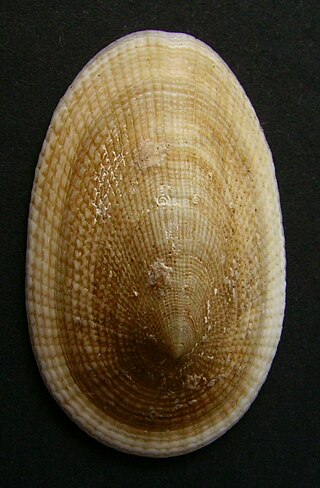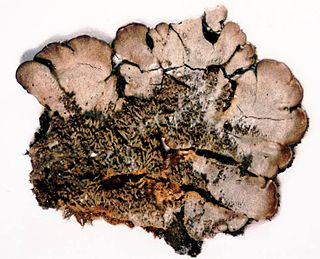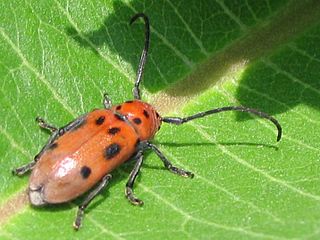
Caenorhabditis elegans is a free-living transparent nematode about 1 mm in length that lives in temperate soil environments. It is the type species of its genus. The name is a blend of the Greek caeno- (recent), rhabditis (rod-like) and Latin elegans (elegant). In 1900, Maupas initially named it Rhabditides elegans. Osche placed it in the subgenus Caenorhabditis in 1952, and in 1955, Dougherty raised Caenorhabditis to the status of genus.

Palaeoniscum is an extinct genus of ray-finned fish from the Permian period (Guadalupian-Lopingian) of England, Germany, Turkey, North America and Greenland, and possibly other regions. The genus was named Palaeoniscum in 1818 by Henri Marie Ducrotay de Blainville, but was later misspelled as Palaeoniscus by Blainville and other authors. Palaeoniscum belongs to the family Palaeoniscidae.

The Palaeonisciformes, commonly known as "palaeoniscoids" are an extinct grouping of primitive ray-finned fish (Actinopterygii), spanning from the Silurian/Devonian to the Cretaceous. They are generally considered paraphyletic, but their exact relationships to living ray-finned fish are uncertain. While some and perhaps most palaeoniscoids likely belong to the stem-group of Actinopteryii, it has been suggested that some may belong to the crown group, with some of these possibly related to Cladistia and/or Chondrostei. Many palaeoniscoids share a conservative body shape and a similar arrangement of skull bones.

Tugali is a genus of small sea snails or limpets, a marine gastropod mollusc in the subfamily Emarginulinae of the family Fissurellidae, the keyhole limpets and slit limpets.

Coccocarpia is a genus of lichen-forming fungi in the family Coccocarpiaceae.

Palaeoniscidae is an extinct family of "palaeoniscoid" ray-finned fishes (Actinopterygii).. The family includes the genus Palaeoniscum and potentially other Palaeozoic and Mesozoic early actinopterygian genera. The name is derived from the Ancient Greek words παλαιός and ὀνίσκος.

Cochlespira elegans, common name the elegant star turrid, is a species of sea snail, a marine gastropod mollusk in the family Cochlespiridae.

Ancistrosyrinx is a genus of sea snails, marine gastropod mollusks in the family Cochlespiridae.

Cochlespira is a genus of sea snails, marine gastropod mollusks in the family Cochlespiridae.

Nealcidion is a genus of beetles in the family Cerambycidae, containing the following species:

Balanophyllia is a genus of solitary corals in the order of stony corals.

Bero elegans is a species of marine ray-finned fish belonging to the family Cottidae, the typical sculpins. This species is found in the northwestern Pacific Ocean. This species grows to a length of 20 centimetres (7.9 in) TL. It is the only known member of the genus Bero.
Coccocarpia delicatula is a species of foliicolous (leaf-dwelling) foliose lichen in the family Coccocarpiaceae. Known only from the Galápagos Islands and Réunion, it was described as new to science in 2011. Characterised by its rounded, foliose thallus and unique cylindrical isidia, this lichen is similar in appearance to Coccocarpia domingensis but has distinct differences in isidia shape and arrangement. Found on the bark and wood of dead twigs, Coccocarpia delicatula thrives in sunny, wind- and rain-exposed environments.
C. elegans most commonly refers to the model round worm Caenorhabditis elegans. It may also refer to any of the species below. They are listed, first in taxonomic order and, second, alphabetically.

Tetraopes is a genus of longhorn beetles of the subfamily Lamiinae, tribe Tetraopini, containing the following species:

Chromidina elegans is a species of parasitic ciliates. It is a parasite of the cuttlefish Sepia elegans, which was described from off Naples, Italy, by Foettinger in 1881 under the name Benedenia elegans and latter assigned to the genus Chromidina by Gonder, in 1905. The species was redescribed by Chatton & Lwoff in 1935.

Bauruemys is an extinct genus of turtles in the family Podocnemididae.

Solariorbis is a genus of gastropods belonging to the family Tornidae.
Coccocarpia melloniorum is a rare species of foliicolous (leaf-dwelling) lichen in the family Coccocarpiaceae. Found in the Philippines, the lichen is characterised by its microfoliose thallus and squamiform (scale-shaped) isidia.















